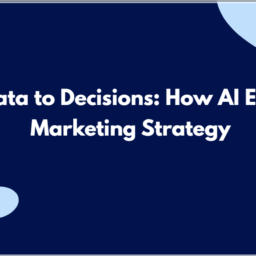In today’s data-driven world, businesses are no longer relying on guesswork to make decisions. Data analytics has become a cornerstone of business growth, providing actionable insights that guide strategy, optimize operations, and enhance customer experiences. Whether you’re a small startup or a large enterprise, leveraging data analytics can unlock new opportunities and drive sustainable growth. Here’s a closer look at the critical role data analytics plays in business growth and how you can harness its power.
1. Understanding Customer Behavior
One of the most significant benefits of data analytics is its ability to provide deep insights into customer behavior. By analyzing data from various sources such as website interactions, social media activity, and purchase history, businesses can gain a comprehensive understanding of their customers’ preferences, needs, and pain points.
How It Drives Growth:
- Personalized Marketing: Use customer data to segment your audience and deliver personalized marketing messages that resonate with individual preferences, leading to higher engagement and conversion rates.
- Improved Customer Retention: Identify patterns in customer behavior that indicate dissatisfaction or churn, allowing you to take proactive steps to retain customers.
- Product Development: Analyze customer feedback and usage data to inform product development, ensuring that new features or products align with customer needs.
Understanding your customers on a deeper level enables you to create more targeted and effective strategies, ultimately driving growth through better customer satisfaction and loyalty.
2. Optimizing Operational Efficiency
Data analytics is not just about understanding customers—it’s also a powerful tool for optimizing internal operations. By analyzing operational data, businesses can identify inefficiencies, reduce costs, and improve productivity.
How It Drives Growth:
- Streamlined Processes: Use data to identify bottlenecks in your operations and implement process improvements that increase efficiency and reduce costs.
- Resource Allocation: Analyze data to determine the most effective allocation of resources, ensuring that you’re investing time and money where they have the greatest impact.
- Supply Chain Optimization: Monitor and analyze supply chain data to identify trends, anticipate demand, and minimize disruptions, leading to more reliable and cost-effective operations.
By improving operational efficiency, businesses can lower costs, increase profitability, and reinvest savings into growth initiatives.
3. Enhancing Decision-Making
Data-driven decision-making is one of the most powerful aspects of data analytics. By providing accurate, real-time insights, data analytics enables businesses to make informed decisions quickly, reducing the risk of costly mistakes and missed opportunities.
How It Drives Growth:
- Strategic Planning: Use data analytics to inform strategic planning, from market expansion to product launches, ensuring that your decisions are backed by solid evidence.
- Competitive Analysis: Analyze competitor data to identify strengths, weaknesses, and market opportunities, helping you to stay ahead of the competition.
- Financial Forecasting: Leverage data analytics to improve financial forecasting, allowing for better budget management and investment planning.
With data-driven decision-making, businesses can respond more effectively to market changes, optimize their strategies, and capitalize on new opportunities.
4. Driving Innovation
Innovation is key to staying competitive in today’s fast-paced business environment, and data analytics can be a catalyst for creative thinking and new ideas. By analyzing trends and patterns in data, businesses can identify emerging opportunities and innovate accordingly.
How It Drives Growth:
- Identifying Market Trends: Use data analytics to spot emerging trends in customer behavior, technology, or the competitive landscape, allowing you to innovate before your competitors.
- Product Innovation: Analyze customer feedback and product usage data to inspire new product features or entirely new products that meet evolving market needs.
- Business Model Innovation: Use data to explore new business models or revenue streams, such as subscription services, that can drive growth and diversify income sources.
Data-driven innovation helps businesses stay relevant and competitive, driving growth by meeting the evolving needs of the market.
5. Measuring and Optimizing Performance
Performance measurement is critical to understanding the effectiveness of your business strategies, and data analytics provides the tools needed to measure, analyze, and optimize performance across all areas of your business.
How It Drives Growth:
- KPIs and Metrics: Define and track key performance indicators (KPIs) that align with your business goals, using data analytics to monitor progress and identify areas for improvement.
- A/B Testing: Use data analytics to conduct A/B testing on marketing campaigns, website changes, or product features, allowing you to optimize your strategies based on real-world results.
- Continuous Improvement: Leverage data to identify successful strategies and replicate them across your business while also pinpointing underperforming areas for improvement.
By continuously measuring and optimizing performance, businesses can ensure that they are always moving toward their growth objectives.
6. Enhancing Customer Experience
In today’s customer-centric market, delivering exceptional customer experiences is key to growth. Data analytics enables businesses to understand and enhance every aspect of the customer journey, from the first interaction to post-purchase support.
How It Drives Growth:
- Personalized Experiences: Use data to create personalized experiences across touchpoints, from targeted marketing campaigns to tailored customer service interactions.
- Customer Journey Mapping: Analyze data from various touchpoints to map the customer journey and identify opportunities to improve the experience at each stage.
- Proactive Support: Use predictive analytics to anticipate customer needs or issues and offer proactive support, increasing customer satisfaction and loyalty.
By enhancing the customer experience, businesses can build stronger relationships, increase customer lifetime value, and drive growth through repeat business and referrals.



